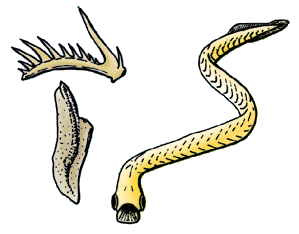Related Research Articles

Conodonts are extinct agnathan chordates resembling eels, classified in the class Conodonta. For many years, they were known only from tooth-like microfossils found in isolation and now called conodont elements. Knowledge about soft tissues remains limited. The animals are also called Conodontophora to avoid ambiguity.

Hindeodus is an extinct genus of conodonts in the family Anchignathodontidae. The generic name Hindeodus is a tribute to George Jennings Hinde, a British geologist and paleontologist from the 1800s and early 1900s. The suffix -odus typically describe’s the animal’s teeth, essentially making Hindeodus mean Hinde-teeth.
Taphrognathus is an extinct genus of conodonts from the Dinantian.
The Whiterockian, often referred to simply as the Whiterock, is an earliest or lowermost stage of the Middle Ordovician. Although the Whiterockian or Whiterock Stage refers mainly to the early Middle Ordovician in North America, it is often used in the older literature in a global sense.
Periodon is a genus of conodonts which existed in what is now Canada, Iran, Argentina, China, Russia, and the United States during the Ordovician Period. It was described by Hadding in 1913, and the type species is P. aculeatus.
Cordylodontidae is a family of conodonts.
Ozarkodina is an extinct genus of conodonts in the family Spathognathodontidae.
George Jennings Hinde was a British geologist and paleontologist.
Acodus is an extinct genus of conodonts.
Paracordylodus is an extinct genus of conodonts in the clade Prioniodontida, also known as the "complex conodonts". The species P. gracilis has been recovered from the chert of the Narooma Terrane, a geological structural region on the south coast of New South Wales, Australia.
Icriodus is an extinct conodont genus in the family Gnathodontidae.
Neogondolellla is an extinct genus of conodonts. Neogondolela regalis was re-evaluated in 2018 by Martyn Lee Golding.
Metapolygnathus is an extinct genus of platform conodonts.
Carnepigondolella is an extinct genus of conodonts of the Late Triassic of Italy or Canada.
Kraussodontus is an extinct genus of gondolellid ozarkodinid conodonts of the Late Triassic in the Pardonet Formation of Canada.
Epigondolella is an extinct genus of conodonts in the family Gondolellidae.
Kallidontus is an extinct genus of conodonts.

Variabiloconus is an extinct genus of conodonts.
Histiodella is an extinct genus of conodonts.
Protohertzina is a genus of conodonts or, possibly, Chaetognaths, found at the beginning of the Cambrian explosion.
References
- ↑ Five new genera of conodonts from the Carnian-Norian boundary beds of Black Bear Ridge, northeast British Columbia, Canada. Michael J. Orchard, New Mexico Museum of Natural History and Science Bulletin, 2013, volume 61, pages 445–457